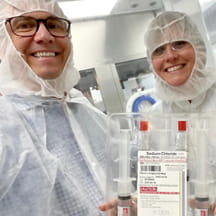The COVID-19 pandemic has caused severe disruption in the global supply chain. Consumers and businesses alike are feeling the crunch, and children’s hospitals are not immune to the supply chain pressures.
Children’s Hospitals Today caught up with Craig Seemann, MBA, vice president and chief supply chain officer at Nationwide Children’s Hospital in Columbus, Ohio, to discuss the challenges associated with keeping supply shelves stocked—and what changes we can expect to last into the future.
How did the onset of the COVID-19 pandemic affect your ability to source products, and what kinds of challenges are you still facing today?
In the early stages, it was very focused on five or six categories of general PPE—things like masks, gloves and gowns. It was manageable—probably 25 or 30 products—but as reality set in and cases started to increase, it was clear the product codes we had been purchasing were in high demand.
That really kicked off the initial wave of trying to source as much as you could. As things dried up in the market, there was more of an intensive effort to source alternatives, and it became a bit of a race. You were just trying to figure out what an appropriate alternative was and decide pretty quickly because if you lagged at all, those products would also dry up quickly.
Today, organizations are generally pretty healthy on their PPE supplies; what we’re dealing with now are the effects related to shortages in labor, weather-related resin materials and raw materials impacting the manufacturing of plastics. We’re also seeing container shortages given the massive global demand, and backups at the ports and not enough truck drivers and rail cars in play. It's that downstream impact that is creating a lot of the shortages of non-PPE-related supplies.
What we're experiencing now is an environment that's more challenging today than I would say it was six months or even a year ago, because the breadth of disruption is so wide. It's not just that core group of 25 PPE items that turned into 200. It's everything else—it's just so hard to forecast.
What are you doing to address these challenges?
We've had to put more resources into sourcing so we can manage a much broader set of data and get as far upstream into distribution channels and manufacturing channels as possible.
We're dialing in on the items that are the highest risk to patient care.
Given the breadth of backordered or unavailable supplies, we’re really trying to dial in on the core items that are the highest risk to patient care. We've gotten a lot of engagement from the clinical teams—getting people on the phone or in emergency meetings to make quick decisions on viable alternatives.
Right now, it’s about scrambling to bring the right people together to get creative about viable options, calling every supplier we can think of, getting creative with new suppliers or even non-traditional suppliers who might be able to help us.
Where are we in the curve? Have we gotten through the worst of it, or is that yet to come?
It's hard to predict., I'm not sure we have the clarity we need on the root cause of the problem. It's a bit challenging to say where we are in the grand scheme of things. I can't imagine it getting much worse, but I feel like there's risk. And we're talking about a real crisis if it does get much worse.
From what I’m hearing, we're going to continue to have challenges through at least the first quarter of 2022 and, in some cases, probably through the balance of 2022. It will likely end up being category- or product-specific; there are some plastic-related items we're going to be challenged on for the next 12 to 15 months.
For others, I'm hearing they're able to stand up other manufacturing lines to meet the volume demand over the coming quarter. It's on a case-by-case basis—but in aggregate, we're going to continue to struggle for probably at least another six months.
How do you foresee these experiences changing the landscape of the global supply chain moving forward and how sourcing managers like yourself navigate it?
During my tenure at Nationwide Children’s, we've always managed a disaster-related inventory. I'm not sure where we will go in terms of the inventory management model longer term, but we'll continue to be focused on the products we need to keep in stock.
I also think that will drive continued engagement with the clinical teams, and we'll take the opportunity to engage even more physicians in the way supply chain resiliency is modeled for Nationwide Children's.
It will be interesting to see how the national landscape changes. Some organizations have already made the decision that they're going to ramp up on their own warehousing; I don't think people will have short memories related to COVID-19.
And we're already seeing some of the major manufacturers onshoring or nearshoring production, so you have production coming out of China and coming back to the U.S. and South America. As we continue to see shifting to more onshore and nearshore manufacturing, it will make for a more fortified supply chain.
Bottom line, people still have other responsibilities on top of all this. It's not like you can drop the rest of the work and only focus on disruptions and things COVID-19-related. Most organizations continue to grow, facilities expand and we all perpetually go through system upgrades and conversions—these can all be very labor-intensive.
It's all part of the churn, and I think that's also part of the reason why the environment is challenging—people are trying to figure out how to resource things and be smart about how they create the roadmap over the next several years.

